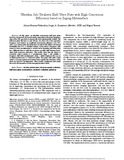Ultrathin sub-terahertz half-wave plate with high conversion efficiency based on zigzag metasurface
Fecha
2020Versión
Acceso abierto / Sarbide irekia
Tipo
Artículo / Artikulua
Versión
Versión aceptada / Onetsi den bertsioa
Impacto
|
|
10.1109/TAP.2020.2993308
Resumen
In this communication, an ultrathin transmissive half-wave plate (HWP) based on a bi-layered zigzag metasurface operating at the lower frequency edge of the terahertz (THz) spectrum is numerically and experimentally studied. The thickness of HWP is only 100 μm and less than λ /20 at the operation frequency, and it achieves an amplitude transmission efficiency over 90% and a cross-polarization dis ...
[++]
In this communication, an ultrathin transmissive half-wave plate (HWP) based on a bi-layered zigzag metasurface operating at the lower frequency edge of the terahertz (THz) spectrum is numerically and experimentally studied. The thickness of HWP is only 100 μm and less than λ /20 at the operation frequency, and it achieves an amplitude transmission efficiency over 90% and a cross-polarization discrimination around 30 dB within a fractional bandwidth near 9%. A detailed analysis of the device robustness with respect to layer misalignments is carried out by designing and fabricating two additional devices with the maximum possible shift between layers along both transverse directions. The results show that the device is extremely robust relative to a misalignment along x and exhibits a frequency shift with misalignments along y , while maintaining in all cases an excellent performance as a HWP. The communication ends with a final study to ascertain a physical mechanism that explains the robustness of the device in regard to misalignments. These results complement and extend the reach of metasurfaces in the emerging THz band. [--]
Materias
Circular polarization,
Electromagnetic radiation,
Half-wave plate (HWP),
Metasurfaces,
Polarizer,
Terahertz (THz) radiation
Editor
IEEE
Publicado en
IEEE Transactions on Antennas and Propagation vol. 68, no. 11, pp. 7700-7704, Nov. 2020
Departamento
Universidad Pública de Navarra. Departamento de Ingeniería Eléctrica, Electrónica y de Comunicación /
Nafarroako Unibertsitate Publikoa. Ingeniaritza Elektrikoa, Elektronikoa eta Telekomunikazio Ingeniaritza Saila /
Universidad Pública de Navarra/Nafarroako Unibertsitate Publikoa. Institute of Smart Cities - ISC
Versión del editor
Entidades Financiadoras
This work was supported by the Spanish Ministerio
de Ciencia, Innovación y Universidades under Project RTI2018-094475-
B-I00 (MCIU/AEI/FEDER, UE). The work of Alexia Moreno-Peñarrubia
was supported by the Universidad Pública de Navarra (UPNA) through the
Formación de Personal Investigador (FPI) Ph.D. Grant Program. The work
of Sergei A. Kuznetsov was supported in part by the Ministry of Science
and Higher Education of the Russian Federation under Project FSUS-2020-
0029 and in part the Russian Foundation for Basic Research under Project
18-29-20066.





